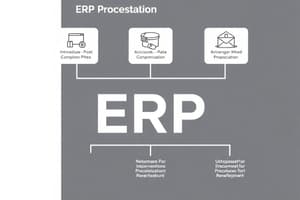Podcast
Questions and Answers
What is the main purpose of a sandbox instance?
What is the main purpose of a sandbox instance?
- To store production data securely
- To conduct live operations without interruptions
- To facilitate testing without affecting real-world data (correct)
- To upgrade the main system software
How does a sandbox instance contribute to learning and experimentation?
How does a sandbox instance contribute to learning and experimentation?
- It prevents users from making any changes.
- It provides a safe space for users to explore and test changes. (correct)
- It requires users to obtain special permissions for access.
- It offers a way to alter the production environment directly.
Which statement best describes the isolation of a sandbox instance?
Which statement best describes the isolation of a sandbox instance?
- It operates separately, ensuring no effect on live operations. (correct)
- It is fully integrated with the main system and shares its resources.
- It can automatically sync changes with the production environment.
- It limits access to only specific user roles in an organization.
Which term best describes individuals or groups that implement new strategies within an organization?
Which term best describes individuals or groups that implement new strategies within an organization?
What is a potential risk of not using a sandbox instance for testing?
What is a potential risk of not using a sandbox instance for testing?
What is a significant benefit of using a sandbox instance for software development?
What is a significant benefit of using a sandbox instance for software development?
Which characteristic is most associated with sandbox instances?
Which characteristic is most associated with sandbox instances?
How do individuals or groups that facilitate change within an organization typically operate?
How do individuals or groups that facilitate change within an organization typically operate?
What is a common misconception about sandbox instances?
What is a common misconception about sandbox instances?
What distinguishes a sandbox instance from the production environment?
What distinguishes a sandbox instance from the production environment?
What is a primary function of a sandbox instance in a development environment?
What is a primary function of a sandbox instance in a development environment?
Which of the following best describes the significance of a sandbox instance in organizational change?
Which of the following best describes the significance of a sandbox instance in organizational change?
How does a sandbox instance help individual drivers of change within an organization?
How does a sandbox instance help individual drivers of change within an organization?
Which characteristic is essential for sandbox instances to function effectively?
Which characteristic is essential for sandbox instances to function effectively?
What role does a sandbox instance play in the learning process of users within an organization?
What role does a sandbox instance play in the learning process of users within an organization?
A sandbox instance is used for testing and experimentation without affecting the live environment.
A sandbox instance is used for testing and experimentation without affecting the live environment.
Sandbox instances should always be used directly in a live environment to validate changes.
Sandbox instances should always be used directly in a live environment to validate changes.
Individuals who implement new strategies in an organization are often referred to as change agents.
Individuals who implement new strategies in an organization are often referred to as change agents.
Using a sandbox instance is unnecessary for organizations that have strong quality control measures.
Using a sandbox instance is unnecessary for organizations that have strong quality control measures.
Sandbox instances help users learn by allowing them to explore and test without real-world consequences.
Sandbox instances help users learn by allowing them to explore and test without real-world consequences.
Match the following terms related to sandbox instances with their definitions:
Match the following terms related to sandbox instances with their definitions:
Match the roles with their descriptions in facilitating change within organizations:
Match the roles with their descriptions in facilitating change within organizations:
Match the following functionalities of a sandbox instance with their purposes:
Match the following functionalities of a sandbox instance with their purposes:
Match the concepts with their roles in software development and organizational change:
Match the concepts with their roles in software development and organizational change:
Match the following scenarios with their significance in using a sandbox instance:
Match the following scenarios with their significance in using a sandbox instance:
Flashcards
What is a sandbox instance?
What is a sandbox instance?
A sandbox instance is a safe and isolated environment where you can test, experiment, or develop software without affecting the real-world environment.
What are the benefits of a sandbox instance?
What are the benefits of a sandbox instance?
A sandbox instance allows developers and users to try out new features, explore changes, or learn new skills without fear of disrupting the live system.
When are sandbox instances used?
When are sandbox instances used?
A sandbox instance is commonly used for testing new software updates, experimenting with new code, or learning new technologies.
What is a change agent?
What is a change agent?
Signup and view all the flashcards
Why are change agents important?
Why are change agents important?
Signup and view all the flashcards
Who are change agents?
Who are change agents?
Signup and view all the flashcards
How do sandbox instances protect live systems?
How do sandbox instances protect live systems?
Signup and view all the flashcards
What is a key benefit of using sandbox instances?
What is a key benefit of using sandbox instances?
Signup and view all the flashcards
Why are change agents important to organizations?
Why are change agents important to organizations?
Signup and view all the flashcards
What is the benefit of using sandbox instances?
What is the benefit of using sandbox instances?
Signup and view all the flashcards
What is the importance of change agents?
What is the importance of change agents?
Signup and view all the flashcards
What are sandbox instances used for?
What are sandbox instances used for?
Signup and view all the flashcards
How do sandbox instances protect the live system?
How do sandbox instances protect the live system?
Signup and view all the flashcards
What are the benefits of using Sandbox Instances?
What are the benefits of using Sandbox Instances?
Signup and view all the flashcards
Study Notes
Modern ERP
- Focuses on selecting, implementing, and utilizing advanced business systems.
- Chapter 6 covers the ERP life cycle, specifically implementation and operation and maintenance.
ERP Life Cycle Stages
- Planning (Chapter 5)
- Package Selection (Chapter 5)
- Implementation (Chapter 6)
- Operation and Maintenance (Chapter 6)
ERP Life Cycle: Implementation
-
Installation: The process of smoothly changing from one software package to another, minimizing problems.
-
ERP software requires an instance to run.
-
ERP Instance Types:
- Sandbox/development instance: for configuration testing and custom development (even after go-live).
- Testing instance: for testing and quality assurance (QA).
- Production instance: the live system.
-
Sandbox instance: A separate software environment for testing, experimentation, or development without impacting the live environment.
-
Configuration: Adjusting business and functional settings to align with customer needs, using pre-built software configurations.
-
Important Note: Configuration does not involve changing core software code, but rather using configuration tables to tailor aspects of the system. It offers options for business processes and organizational setup (e.g., pricing methods, credit management, default currency).
-
Customization: Altering the software to support unique business processes or competitive advantages.
- May be necessary due to compliance, regulatory, reporting, or legislative issues.
- Types of Customization:
- Enhancements: Adding fields, changing the screen layout, or adding extra steps in the process.
- Modifications: Changes to the core code to address requirements that the standard software cannot handle.
-
Testing: Ensures the software behaves as expected.
- A dedicated development instance facilitates testing.
- Conference Room Pilot (CRP): Temporary conference room sessions support testing, allowing employees to execute transactions with proposed system configurations.
- Testing Types:
- Unit testing: Testing small functional increments or individual objects.
- Integration testing: Testing the end-to-end business processes.
- Customer acceptance testing: Users test the system with realistic business situations for approval/acceptance.
- Security testing: Testing all user roles and security aspects.
-
Change Management: addresses organizational change effectively.
- Gets employees trained and prepared for new processes.
-
Change Agent: Individual designated to lead organizational change effort.
- Should have clout, conviction, and charisma to engage employees.
Top Ten Principles of Change Management
- Address the "human side" systematically.
- Start at the top.
- Involve every layer.
- Make the formal case.
- Create ownership.
- Communicate the message.
- Assess the cultural landscape.
- Address culture explicitly.
- Prepare for the unexpected.
- Speak to the individual.
ERP Life Cycle: Implementation (continued)
- Interfacing with Other Systems: Addresses the interfaces needed for existing systems due to time/cost/functional issues and political considerations.
- Training: Teaches new processes, rather than just the software interface; needs to be developed by the project team. This includes a curriculum. Key elements of effective training include focusing on business processes, relating to existing environments, utilizing various tools, a train-the-trainer approach, sufficient time allocation, and reinforcement through organizational approaches. Six key strategies for employee training are:
- Focus on business processes, not transactions
- Relate new business processes to the existing environment
- Leverage a multitude of tools for ERP training
- Use a train-the-trainer approach
- Allocate plenty of time for ERP implementation training
- Reinforce training with more comprehensive organizational approaches
- Consultants: Assist project teams with various activities, including business case development, package selection, process documentation, change management, training, project management, and functional knowledge. When choosing consultants, consider their industry expertise, successful implementation history, ongoing support, and whether ongoing or one-time implementations are needed. Consider if they have experience with the specific industry and number of successful implementations. Also consider if they provide ongoing services.
Benefits and Risks of Using Consultants
- Benefits: Unbiased perspective, knowledge of vendors and best practices, implementation experience, better overview, innovative ideas, senior management support, more likely to improve the implementation strategy, and to effectively address implementation-related challenges.
- Risks: Bias towards specific software vendors, lack of understanding of the client's business processes, advocacy of particular best practices, cost issues, lack of process detail knowledge transfer, and inadequate support capabilities.
Implementation Methodologies
- Phased Implementation: Rollout by functional area, division, or geographic area. Allows different parts of the company to maintain regular operations while other parts utilize the new ERP system.
- Big Bang Implementation: Implementing the entire ERP system at once, replacing all legacy systems or business processes at the same time.
- Franchising Implementation: Installing independent ERP systems in different business units within the organization but linking common processes.
- On-Demand/SaaS Implementation: Utilizing hosted software solutions; no on-site software installation is required.
Comparison of Different ERP Implementation Approaches
- Presents different implementation approaches using a table that contains factors like Time, Internal Cost, External Cost, Amt of Change, and ROI. Different approaches (Balanced, Turnkey, Customer-Driven, La Carte) have varying advantages and disadvantages.
ERP Life Cycle: Operation and Maintenance
- Stabilization Period: ERP system performance may dip initially due to ongoing training and process adjustments. A post-mortem session by the project team is recommended.
- Maintenance Activities:
- Preventative maintenance: Regularly scheduled tasks to ensure proper system functioning.
- Emergency maintenance: Actions to fix critical issues promptly.
- Software Updates: ERP vendors often release updates or fixes, which are important for improving system performance, applying new best practices, and fixing bugs.
Upgrading ERP Systems
- Applying updates, fixes, and improvements to the company's current ERP system.
- Reasons for updating: Competitive advantage, new capabilities, surpassing competitors, enhancing the flow of information, improved integration, improved operational efficiency, adhering to best practice implementations or addressing issues with insufficient features or uncertain quality.
Reasons Companies Do Not Upgrade Systems
- Insufficient features, uncertain quality, too many customizations, budget or cash-flow concerns, and a long or complicated upgrade process. Reasons are quantified in a chart. Factors are insufficient features, uncertain quality, excessive customizations, budget/cash flow problems, and too long/hard upgrade process. Additional factors include uncertain quality, insufficient features, too many customizations, and process that is too long or difficult.
Studying That Suits You
Use AI to generate personalized quizzes and flashcards to suit your learning preferences.





